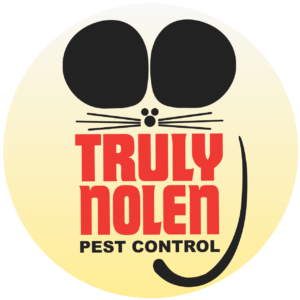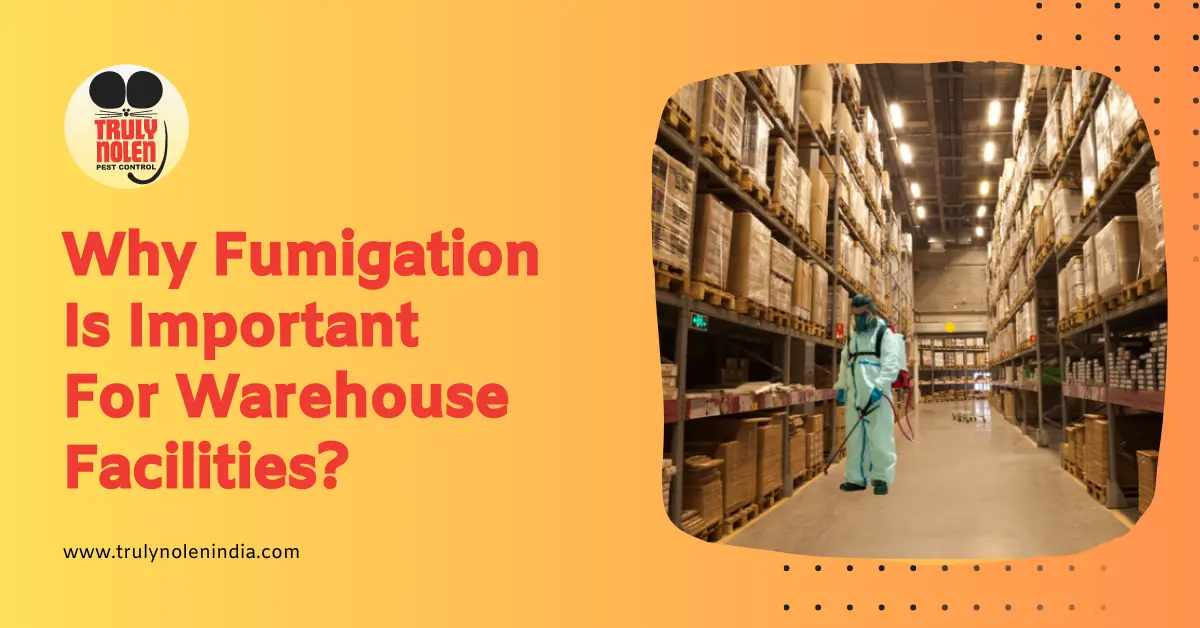Imagine this: you’ve built a thriving warehouse facility meticulously organized with precision and care. Every item has its place, and your operations continue seamlessly.
But amidst the impressive efficiency and organization, a hidden enemy lurks in the shadows, ready to strike when you least expect it.
We’re talking about pests—the unwelcome guests that can turn your haven of productivity into a nightmare of infestation.
In this blog, we uncover why fumigation is important for warehouse facilities and how it holds the key to protecting your inventory from these relentless intruders.
Let’s start!
What Is Fumigation In Warehouse Facilities?
Fumigation for warehouse facilities refers to using fumigants or chemicals in gaseous or volatile state, to prevent pests or control pest infestations within the warehouse. This pest control method involves creating a gas-tight environment within the facility and introducing a fumigant in a concentration sufficient to control the target pests.
The Fumigation Process In warehouse Facilities

Here’s an overview of the fumigation process in warehouse facilities:
- Assessment and Preparation: The warehouse is assessed for pest infestation and specific requirements, and preparations are made by covering the commodities with tarpaulin, and ensuring a secure seal to prevent gas leakage.
- Fumigant Application: The chosen fumigant is applied through various methods based on the stack size and layout, such as releasing gas from containers or using specialized equipment to disperse it evenly.
- Exposure Period: The fumigant concentration is maintained at the appropriate level for a specified time to effectively control pests, considering factors like fumigant type, target pests, temperature, and environmental conditions.
- Aeration and Safety Measures: After the exposure period, the warehouse is aerated to remove the fumigant and ensure a safe working environment, introducing fresh air and actively removing residual gases.
- Post-Fumigation Monitoring: Inspections and monitoring are conducted to confirm the treatment’s effectiveness and ensure pest prevention, utilizing visual inspections, trapping methods, or other techniques.
Note: Fumigation should be performed by trained professionals who possess the expertise, follow safety protocols, and have access to appropriate fumigants and equipment to ensure regulatory compliance and industry best practices.
Types Of Pests In Warehouses
To understand why fumigation is important for warehouse facilities, we must familiarize ourselves with the common pests in warehouse settings. These include:
- Rodents (Rats, Mice): Rodents are notorious for their ability to cause extensive damage. They can chew through packaging, contaminate products, and create breeding grounds within the warehouse. Their constant gnawing behavior also poses fire hazards due to damaged electrical wires.
- Insects (Ants, Beetles, Cockroaches): Insects are adept at infiltrating warehouses through small cracks and crevices. Once inside, they can quickly multiply and cause damage to stored goods. Additionally, they contaminate products with their droppings, urine and shed skin, leading to product quality deterioration.
- Stored Product Pests (Beetles, Weevils, Moths): Stored product pests are attracted explicitly to stored grains, cereals, and other dry commodities. They infest and damage these goods, rendering them unfit for consumption or sale. Beetles, weevils and moths are common culprits in this category, causing extensive losses if left unchecked.
Problems Caused By Pests In Warehouse Facilities

Pest infestations in warehouse facilities can lead to a range of significant problems that can negatively impact operations, product quality, and the well-being of employees. Understanding these problems highlights the critical need for effective pest control measures, including regular fumigation. Let’s delve into the potential risks and negative consequences associated with pests in warehouse environments.
- Damage to Goods: Pests, such as rodents, insects, and stored product pests, have a voracious appetite and a penchant for chewing through packaging materials. This can directly damage goods, leading to financial losses for businesses. Rodents, for example, can gnaw through electrical wires, causing fire hazards and destroying stored inventory.
- Contamination of Products: Pests can contaminate products in various ways. Rodents and insects may leave droppings, and urine, or shed skin, contaminating food, pharmaceuticals, and other sensitive products. This contamination poses serious health risks and can lead to product recalls, loss of customer trust, and legal implications.
- Spread of Diseases: Pests are carriers of various diseases and pathogens that can significantly threaten human health. Rats and mice, for instance, can transmit diseases like leptospirosis, hantavirus, and salmonellosis. In a warehouse where employees handle goods, a pest-infested environment can expose workers to harmful diseases, leading to absenteeism, decreased productivity, and potential legal issues.
- Harm to Employees’ Health: Pests not only pose risks to the products within a warehouse but also to the health and well-being of employees. Insects like cockroaches and ants can cause allergies and trigger asthma attacks, especially in individuals who are already sensitized. Moreover, pests can increase employee stress levels and decrease overall workplace morale.
By understanding the problems associated with pest infestations and recognizing the various types of pests commonly found in warehouses, businesses can appreciate the urgency of implementing effective pest control strategies. Pest control, in particular, plays a vital role in mitigating these risks and maintaining a pest-free environment in warehouse facilities.
Why Fumigation Is Important For Warehouse Facilities?

Warehouse facilities are vital in storing and distributing goods, serving as the backbone of supply chains. However, warehouses face various challenges, including the threat of pests and the potential damage they can cause to stored products. Fumigation for warehouse facilities becomes an essential practice to ensure the integrity of stored goods and maintain optimal conditions. Let us explore why fumigation is important for warehouse facilities:
1. Pest Control and Prevention
- One of the primary reasons why fumigation is important for warehouse facilities is to control and prevent pests.
- Pests such as rodents, various insects and other pests can infest stored goods, leading to contamination, spoilage, and significant financial losses.
- Pest control as well as fumigation is a highly effective method for stopping these pests and maintaining a pest-free environment.
- One of the primary reasons why fumigation is important for warehouse facilities is to control and prevent pests.
- Pests such as rodents, various insects and other pests can infest stored goods, leading to contamination, spoilage, and significant financial losses.
- Pest control as well as fumigation is a highly effective method for stopping these pests and maintaining a pest-free environment.
2. Protection of Stored Products
- Warehouses store many products, including food, pharmaceuticals, textiles, etc.
- These products are susceptible to damage caused by pests, including contamination, spoilage, and degradation.
- Fumigation helps protect stored products by preventing pests that can cause such damage. By implementing regular fumigation procedures, warehouse operators can ensure the quality and safety of the stored goods, protecting their value and reducing the risk of product recalls or customer complaints.
3. Compliance with Health and Safety Regulations
- Health and safety regulations play a crucial role in warehouse operations, and fumigation is essential to maintaining compliance.
- Pests in warehouses can pose serious health risks, including the spread of diseases, contamination of food products, and allergic reactions.
- Failure to address these concerns can result in legal and financial repercussions for warehouse operators.
- Fumigation helps ensure compliance with regulations by minimizing the presence of pests and maintaining a clean and safe environment within the facility.
4. Preserving Structural Integrity
- Pests can also cause damage to the physical structure of warehouse facilities.
- Rodents, termites, and other pests are notorious for gnawing on electrical wires, insulation, and wooden structures, leading to fire hazards and structural instability.
- Pest control not only prevents pests but also prevents their destructive behavior, preserving the structural integrity of the warehouse.
- By mitigating the risk of structural damage, pest control contributes to the long-term sustainability and functionality of the facility.
5. Preventing Cross-Contamination
- Warehouse facilities often handle different types of goods, and cross-contamination between products can have severe consequences.
- Pests can carry bacteria, pathogens, or allergens, and their movement within the warehouse can result in cross-contamination between stored items.
- Pest control in different forms helps prevent cross-contamination by reducing the risk of pest movement between storage areas.
- By maintaining a safe environment, warehouse operators can uphold the quality standards of their stored products.
6. Preventing Reputation Damage
- Pest infestations in warehouse facilities can have a detrimental impact on the reputation of the business.
- If products become contaminated or compromised due to pests, it can lead to negative reviews, loss of customer trust, and damage to the brand image.
- Pest control helps prevent pest-related incidents and ensures that stored goods are protected from contamination, safeguarding the warehouse facility’s reputation and associated businesses.
7. Minimizing Financial Losses
- Pests can cause significant financial losses for warehouse facilities.
- The damage caused by pests can result in the loss of entire product batches, rendering them unfit for sale or consumption.
- Additionally, the costs associated with replacing damaged products, cleaning up infested areas, and repairing structural damage can be substantial. Effective pest control is a proactive measure to prevent pests and minimize the risk of financial losses, ensuring that stored goods remain intact and of high quality.
8. Complementing Integrated Pest Management (IPM) Programs
- Warehouse facilities often implement Integrated Pest Management (IPM) programs to address pest issues.
- Fumigation is an essential component of an IPM approach by providing a targeted and effective solution against stored grain pests that have already infiltrated the commodities in the facility.
- By integrating fumigation in various commodities and an overall pest management strategy, warehouse operators can enhance the effectiveness of their IPM programs and achieve better long-term pest control results.
9. Meeting Regulatory and Customer Requirements
- Specific industries, such as food and pharmaceuticals, are subject to stringent regulatory requirements concerning pest control and sanitation.
- Fumigation is crucial for warehouse facilities operating in these sectors to meet these regulations and maintain compliance.
- Additionally, many customers expect suppliers to adhere to strict pest control standards, especially in the food industry.
- By implementing regular fumigation procedures, warehouse operators can demonstrate their commitment to quality and compliance, ensuring they meet regulatory and customer expectations.
10. Protecting Employee Health and Safety
- Warehouse facilities are responsible for protecting the integrity of stored goods and ensuring their employees’ health and safety.
- Pests can pose health risks to workers, ranging from allergies and respiratory issues to bites and stings.
- Pest control helps create a safe working environment by preventing pests that may pose a threat to employee health.
- By investing in fumigation and pest control, warehouse operators prioritize the well-being of their commodities as well as workforce, fostering a healthier and more productive business and working environment.
Fumigation is important for warehouse facilities, as it ensures pest control and prevention, protects stored products, maintains compliance with health and safety regulations, preserves structural integrity, and prevents cross-contamination. By implementing regular fumigation procedures, warehouse operators can safeguard inventory, maintain customer satisfaction, and optimize operations. Warehouse managers need to work closely with professional fumigation service providers to develop comprehensive pest management plans and ensure the continued success of their facility.
Protecting Warehouses, Preserving Goods: Fumigation Excellence With Truly Pest Solution

At Truly Pest Solution, we understand warehouses’ critical role in storing and distributing goods efficiently. That’s why we offer fumigation services that excel in protecting your warehouses and preserving the integrity of your stored goods.
Our hassle-free and tailored approach ensures a seamless experience for our clients. Our effective integrated pest management methods prioritize the safety of your products, employees, and the environment. Trust our team of experts to unleash the power of fumigation, safeguarding your warehouse facilities from pests and ensuring the longevity of your stored goods.
Experience fumigation excellence with Truly Pest Solution and take the first step towards a safe warehouse today.
Contact us to book a free inspection today!


Leave a Reply